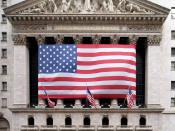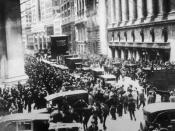The United States Stock Market Crash in October 1929 marked the beginning of the Great Depression.
Background on the Great Depression
The Great Depression was an economic slump in the United States and Europe that began in 1929 and lasted until about 1939. This was the longest and most severe Depression in United States history.
The Depression began with the disastrous collapse of the Stock Market in October 1929. Stock Prices dropped the worst during the third and fourth week of October. But many investors, mostly wealthy, held their stocks and thought that the prices would likely spout up again and that it was just an unlucky week for the market. Some even bought more stocks! Sadly though, three months before the 'roaring twenties' came to a quiet halt, something unpredictable happened, something that the world would never forget. Throughout that week, many people who could not afford their stocks because they had paid "on margin", or only paid a portion of the stock's worth sold them, fearing the stocks would fall further.
The sudden sell left the stocks in possession of the banks, thus leaving the money that was to be owed for the banks. The lack of money put a huge strain on the banks. Not only did many banks own stocks in the Stock Market, but now that the market crashed many banks could not even afford to pay the amount of money owed from the loaner that had paid "On Margin", and many banks consequently failed.
The failure of so many banks, combined with the nationwide loss of confidence in the economy led to reduced spending and demand, thus fewer workers were needed, and hence many jobs were lost. (Cobblestone, Page 6)
The Stock Market crash sparked a downward spiral in the economy of the United...


